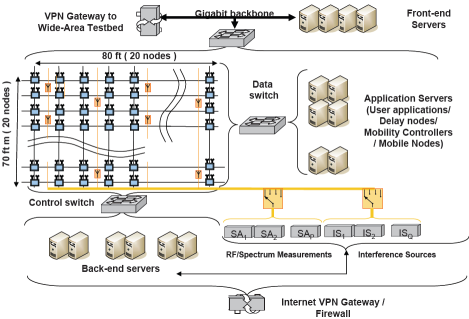| Version 19 (modified by , 11 years ago) ( diff ) |
|---|
Table of Contents
Table of Contents
Hardware
The ORBIT laboratory is comprised of several different test domains in which experimenters can use the hardware provided by WINLAB for use in wireless experimentation. The Orbit grid as illustrated in Figure 1 consists of a multiply interconnected, 20-by-20 grid of ORBIT radio nodes, some non-grid nodes to control R/F spectrum measurements and interference sources, and front-end, application and back-end servers. These servers support various ORBIT services. In addition to the main grid, there are also 9 additional smaller test grids(a.k.a. sandboxes). All this is supported the the back end orbit infrastructure which provides services and control to the test facility.
Each radio node is a PC typically with two 100BaseT Ethernet ports, radio cards and a chassis manager(CM) to control the node. The two Ethernet ports are connected to Data and Control subnet. While Control is used primarily for node access, experiment management and measurement collection, the Data subnet is exclusively available to the experimenter. In addition to the the standard radio cards on most of the nodes, there are many other devices throughout including devices for various communication protocols as well as software radio platforms such as the USRP & USRP2. The full list is found under the devices description page.
Detailed information on the various hardware components that are used to realize the ORBIT testbed can be found by following the links above.
- Chassis Manager(CM) - Each node in ORBIT is equipped with a chassis manager. This section described the details of how the chassis manager is used and the design on the CM
- Cases - This section briefly goes over the various enclosures that have been used to house the nodes
- Assembly - A description of the assembly process for the nodes
Attachments (1)
-
hardware-50.png
(75.1 KB
) - added by 10 years ago.
ORBIT Hardware Block Diagram
Download all attachments as: .zip

